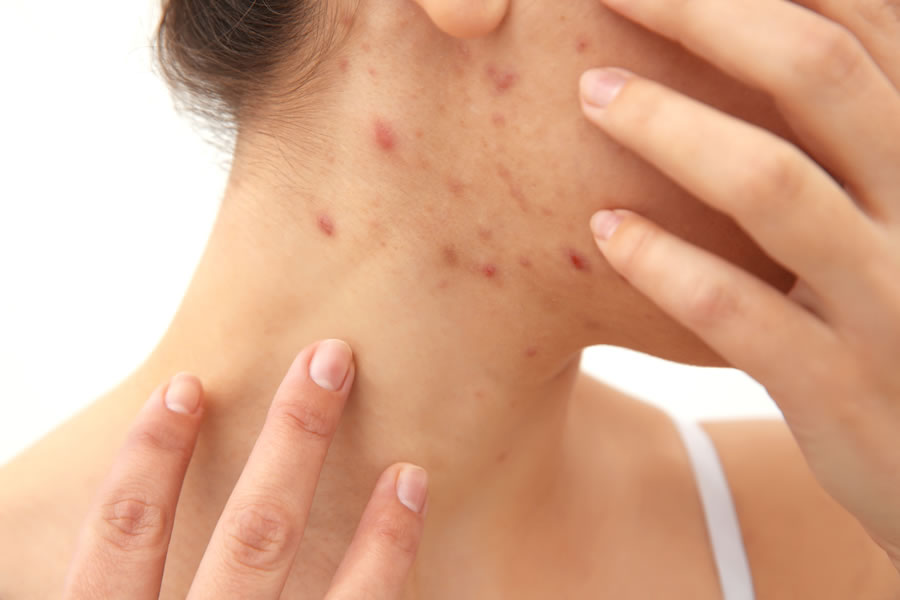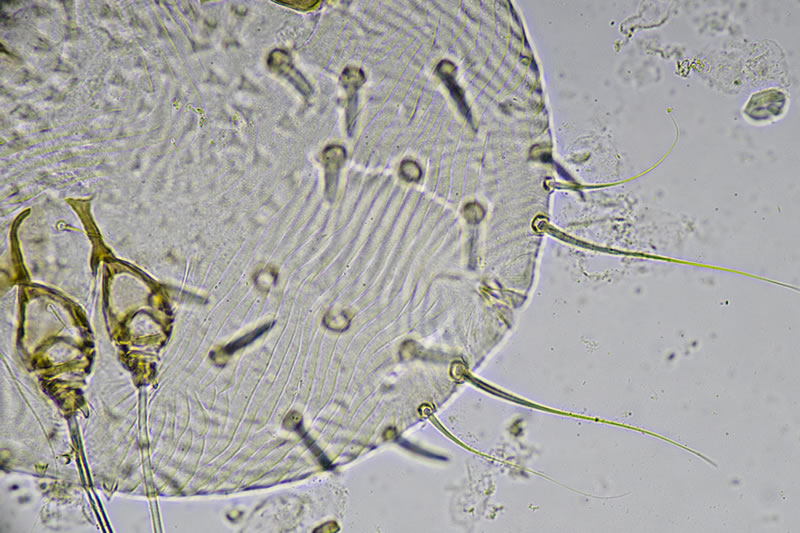Scabies Treatment
Scabies affects about 130 million people in the world at any given time, and is a highly contagious skin disease, transmitted primarily through direct skin contact. Often, scabies gets misdiagnosed as other skin diseases such as eczema or impetigo. Prompt diagnosis and treatment is necessary to prevent the spread of this highly communicable skin disease.
If you’re experiencing an itchy red rash that grows worse overnight, you may have one of the classic symptoms of scabies. Scabies is a skin disease caused by microscopic mites, known as Sarcoptes scabiei, which can live undetected on the surface of the skin. Scabies mites, Sarcoptes scabiei, are known for burrowing into the skin to lay their eggs, and a female mite will typically lay two or three eggs at a time. The mites are so tiny that you usually cannot see them, while they burrow into the top layer of your skin to live and feed. This process can quickly lead to a skin infestation which creates an itchy, uncomfortable rash on the infected person.

A scabies infection is highly contagious and transmits quickly amongst household members, as it rapidly spreads through direct skin-to-skin contact, with young children being even more susceptible to this skin infection. Spread of scabies can also be transmitted through infested bedding, furniture, or clothing; direct skin-to-skin contact is not entirely necessary. If you are exhibiting any of these symptoms, board-certified dermatologist Dr. Michele Green is here to diagnosis your infestation, provide appropriate scabies treatment, and prevent re-infestation.
Scabies Symptoms
Typically, the symptoms of scabies won’t be identifiable for the first several weeks of development. However, after the first six weeks, an infested person will typically have a skin reaction where the burrows develop along the folds of the skin.
Adults and older children will often see symptoms of scabies in the folds between fingers, the wrist, in the armpits, around the waist, in the nipple or genital area, and in the elbow and knee creases. With young children and toddlers, scabies will typically appear on the palms, feet, face, neck, and scalp. Immunocompromised patients are most susceptible to scabies and can present with an intense infection.
Once scabies symptoms begin to develop, intense itching occurs and commonly increases at night. A red rash then usually follows, which indicates the burrow tracks of the scabies mites, appearing as hives, blisters, or pimple-like bumps. If an infected person scratches the affected area, these bumps may develop into sores that can then lead to a secondary infection. In these cases, oral or topical antibiotics may be needed to prevent the spread of a bacterial infection.
A dermatology practice should be your first call when experiencing potential scabies symptoms, as dermatologists, like Dr. Michele Green, are trained to differentiate the symptoms of scabies from other skin conditions. Typically, a diagnosis can be made from the appearance of the rash and description of symptoms, but sometimes a skin scraping will be taken to confirm the scabies infestation. A scabies ink test, where ink is applied to an affected area, may also be used to further determine the specific mite burrows and aid in treatment of the infection.
Crusted Scabies
Crusted scabies, or Norwegian scabies, is a secondary type of scabies that is both extremely contagious and severe. It is more likely to develop in patients with weakened immune systems, such as those with HIV/AIDS, or patients who are taking immunosuppressant medication.
Crusted scabies spreads in the same fashion as typical scabies, but can develop more aggressively and rapidly in a person with a compromised immune system. A crusted scabies skin infection consists of thousands of eggs that create a thick, grayish crust on the skin that often crumbles when touched.
Treatment of Scabies
In order to soothe scabies, a variety of different home remedies can be used. However, to eliminate a scabies infestation, your health care provider will likely recommend one of the following treatments:
- Permethrin cream: this is the most commonly recommended scabies treatment in the United States and the United Kingdom. It is a chemical treatment known as a “scabicide” that is designed to kill human scabies mites and larvae. Resistance to permethrin cream is quite rare, but in the case of irritation or ineffective treatment, a combination of other treatments listed here can be used.
- Ivermectin: this oral medication is recommended for those with weakened immune systems, crusted scabies symptoms, and/or who have not responded to medicinal creams or lotions.
- Lindane lotion: this is an additional chemical treatment often used when permethrin cream is ineffective or can’t be tolerated by the infected patient
Permethrin, Ivermectin and Lindane are the recommended scabies treatments by the Centers for Disease Control and Prevention (CDC). Additional treatments that are sometimes used include:
- Benzyl benzoate lotion
- Sulfur ointment
- Crotamiton cream or lotion: this topical treatment is typically only suggested when other options have failed, as it is not considered safe for those age 65 or older, nor for pregnant women, nursing women, or children.
Itching or skin irritation can last for several weeks after treatment, but this typically does not mean that the treatment was unsuccessful.
If sores are present on a scabies rash, a bacterial infection, such as impetigo, can be quite common. In this case, your doctor may also prescribe an antibiotic to treat this secondary infection.

Home Remedies
The worst symptom of scabies are painful itching and irritation along the infected areas of the body. To soothe these symptoms, there are several at-home treatments you may consider:
- Over-the counter antihistamines
- Applying cool water to the irritated skin
- Soaking in a cool water or oatmeal bath
- Calamine lotion
- Capsiacin cream
If the medicated treatments initially prescribed lead to side effects such as burning, swelling, or numbness, you may consider talking with your health care providers about adjusting your treatment to include one or more of the following home remedies, known to soothe the skin and act as natural insecticides:
- Pure aloe vera
- Essential oils (clove, lavender, lemongrass, nutmeg)
- Neem tree soaps, creams, and oil extract
- Tea tree oil
Home remedies or natural treatments of scabies are not recommended by the FDA or the CDC as the sole treatment for scabies infection. Your dermatologist will work with you to see how home remedies can be incorporated into your scabies treatment plan to help alleviate painful symptoms.
How to Prevent Scabies
Anyone is susceptible to scabies as the mites are merely looking for a home to burrow. Scabies infestations can travel quickly through close contact with others, as well as through furniture and fabrics, which is why child care facilities, nursing homes, or other environments with close quarters are at greater risk for a scabies outbreak. It’s important to notify any family members, sexual partners, or others you’ve come into physical contact with so that they can be treated for potential scabies infections.
If you are living in an environment with a scabies infestation, it is important to wash all fabrics at a high temperature to eliminate any mites that may be living on the material. Items that cannot be washed in hot water should either be put in the freezer or into a plastic bag for 72 hours in order to eliminate scabies mites.
Any shared furniture should be vacuumed and, afterwards, the vacuum should immediately be emptied and then cleaned with disinfectant. If you have had physical or sexual contact with someone who has been diagnosed with a scabies infection, your health provider will likely recommend scabies treatment and a similarly thorough cleaning process.
A common misconception is that scabies can be transferred from humans to pets, or vice-versa. Canine and feline scabies is a different skin disease known as mange, and cannot be treated with scabicide intended for human scabies.
How long does scabies last?
Many patients feel as if they still have scabies even after proper scabies treatment. Scabies mites can live on an individual’s skin for about two months, but once they are not on your skin, they die within a few days. However, the irritation and erythema, which are caused by the mite waste and the eggs that still remain on your skin, persist long after the mite has been eliminated. It is, however, always important to clean your environment after a scabies outbreak to prevent re-infestation, which is a common problem with scabies.
To find out more about how to treat scabies and book an appointment with board certified dermatologist Dr. Michele Green in our NYC office, please don’t hesitate to contact us online today or call 212-535-3088
 212-535-3088
212-535-3088